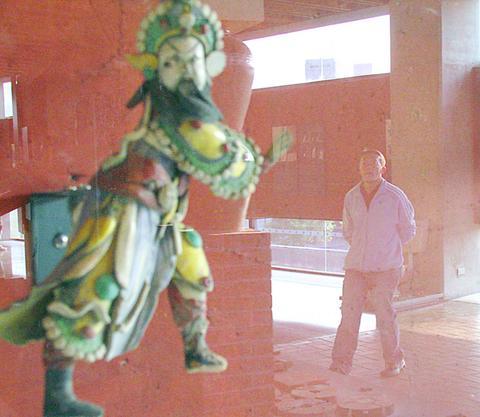Nothing bridges nature and culture more than pottery. That's the idea that the Yingge Ceramics Museum was built on and its permanent exhibits alone make a compelling case for it. Clay was the first thing humans built with and it remains the foundation of the civilized world; from dinner plates to dentures and from engine cylinders to silicon chips.
Now the past two centuries of Taiwan's ceramics history can be seen at the museum in a special exhibition -- 200 Years in Yingge starts today and runs through Saturday, Oct. 30.

PHOTO: DAVID MOMPHARD, TAIPEI TIMES
The cause for the celebration is the arrival in Yingge 200 years ago of Wu An (吳鞍), the first potter from Guangzhou to settle in the area and take up his trade. He was later joined by a brick maker named Chen Kun (陳昆) and the two helped make the area into the center of Taiwan's ceramics industry. Today, Yingge is known as much for the commodes and cable insulators it supplies to the world as for the works of art its craftsmen create.
While a bicentennial is cause to celebrate, there's reason enough to travel to the Taipei County township without it. The Yingge Ceramics Museum is world-class -- not a term usually associated with Taiwan's countless museums -- and the town it sits in has quite literally formed a unique identity for itself over the centuries.
Beginning at the museum, you can learn about the start of Taiwan's ceramics industry, when sampans on the Dahan River floated cups and bowls downstream, and about the prosperous days that came with the railroad. Then you can exit the museum and sift through stacks of plates seven decades deep. You'll be surprised at what you find (locally manufactured Japanese-era rice bowls, for example) and surprised at the cost (NT$100 per piece).
Yingge's history has been captured not only in clay, but through the camera, as well, and the 200-year exhibit's must-see section is Memories of Trains, housed in the town's old train station, next door to the new train station.
Taking the idea that clay bridges nature and civilization a step further, the museum will offer several special activities over the next two weeks as a part of the 200-year anniversary exhibit. A one-day environmental tour of the township will take visitors on a tour of the local incinerator and to a DIY recycling shop. There are also tours of the hundreds of both modern and traditional kilns in the area. Both tours are available weekends only.
The Yingge Ceramics Museum is located at 200 Wenhua Rd, Yinge Township, Taipei County (北縣鶯歌鎮文化路200號). To get there, take the train to the Yingge Railway Station and follow the big green and white signs to the museum and special exhibit centers. The exhibits are open until 5pm on weekdays and until 6pm on weekends. Admission is NT$200. More information about the exhibitions can be viewed on the Web at www.ceramics.tpc.gov.tw.

Exceptions to the rule are sometimes revealing. For a brief few years, there was an emerging ideological split between the Democratic Progressive Party (DPP) and Chinese Nationalist Party (KMT) that appeared to be pushing the DPP in a direction that would be considered more liberal, and the KMT more conservative. In the previous column, “The KMT-DPP’s bureaucrat-led developmental state” (Dec. 11, page 12), we examined how Taiwan’s democratic system developed, and how both the two main parties largely accepted a similar consensus on how Taiwan should be run domestically and did not split along the left-right lines more familiar in

As I finally slid into the warm embrace of the hot, clifftop pool, it was a serene moment of reflection. The sound of the river reflected off the cave walls, the white of our camping lights reflected off the dark, shimmering surface of the water, and I reflected on how fortunate I was to be here. After all, the beautiful walk through narrow canyons that had brought us here had been inaccessible for five years — and will be again soon. The day had started at the Huisun Forest Area (惠蓀林場), at the end of Nantou County Route 80, north and east

Specialty sandwiches loaded with the contents of an entire charcuterie board, overflowing with sauces, creams and all manner of creative add-ons, is perhaps one of the biggest global food trends of this year. From London to New York, lines form down the block for mortadella, burrata, pistachio and more stuffed between slices of fresh sourdough, rye or focaccia. To try the trend in Taipei, Munchies Mafia is for sure the spot — could this be the best sandwich in town? Carlos from Spain and Sergio from Mexico opened this spot just seven months ago. The two met working in the

This month the government ordered a one-year block of Xiaohongshu (小紅書) or Rednote, a Chinese social media platform with more than 3 million users in Taiwan. The government pointed to widespread fraud activity on the platform, along with cybersecurity failures. Officials said that they had reached out to the company and asked it to change. However, they received no response. The pro-China parties, the Chinese Nationalist Party (KMT) and Taiwan People’s Party (TPP), immediately swung into action, denouncing the ban as an attack on free speech. This “free speech” claim was then echoed by the People’s Republic of China (PRC),